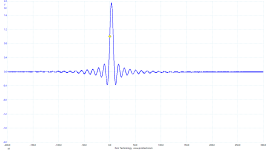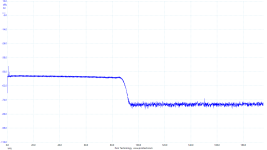That’s always my objective.Perhaps it is generally helpful to view contributions as a kind of friendly (and hopefully constructive) brainstorming session.
But when I have no clue and no further information to clarify is brought forward, then there is litlle to brainstorm, isn’t it.
I don’t think I’m the only one who doesn’t get your message, so it’s most likely not a one to one communication.
Just a missed opportunity.
Hans
An image tells sometimes more than a thousand words."harder to control with single (...)" [Hans Polak]
Can you please explain this belief or assumption in a technically and physically correct way? Because the opposite is the case.
Just stating that the opposite is true is in contradiction with what the simulation is showing, so please tell me how you came to that conclusion.
Hans
The simulation shown has nothing to do with “my equalizer preamp” but is an obvious version with gnd reference.I understand what you're getting at, but let's leave your equalizer preamplifier design and implementation aside and concentrate on all representatives that require a fixed reference potential, GND or even 0V. We in German call it 0V.
Why are you making such insinuations, completely counter productive.
The simulation was a straight answer to the question whether a passive versus an active EQ could shed some light on eventual differences.
Hans
This is where are in complete disagreement.Fully agree, it can then be measured and localized to the mechanism of action by means of correlation and logic. However, only with a strictly analytical approach and reflection.
Actually, the original sub-topic is highlighting the clicks and pops by mishandling the ingredients and misinterpreting the recipe.
Potato soup a tastes better or worse than potato soup b. However, chromatography and mass spectroscopy have clearly shown that a = b and b = a.
Bye,
HBt.

What you are saying is that two amplifiers measuring the same, will sound the same.
If so all Audio magazines only would have to measure and leave the listening part and manufacturers will have a relaxed time to produce equipment according to a measuring standard.
But, I can only repeat that correlation between measuring and sound perception is very weak.
Hans
What is the reason that you keep this Mr. In your postings.not your and not Mr. Polak's topologie, therefor "all others" with GND -> so called unbalanced -> reference
I don’t think it it helps to make the discussions more fluid.
Hans
Certainly. IM requires some form of non-linear transfer function that doesn't necessarily involve clipping. Signals in the pre-RIAA, those that contain higher amplitudes of high frequency signals caused by inverse RIAA, those being in the presence of a non-linear transfer function, can generate amplitudes of distortions that are also increased as a function by some exponent. Those in turn can create intermodulation artifacts magnified lower down in frequency by subsequent RIAA filtering, this in relation to the subsequent upper frequency attenuation caused by the RIAA correction.Does anyone think of intermodulation and its products when he or she speaks of signal processing artifacts?
In the presence of single sided pops and clicks in combination with non-linearities can result in more dominant IM than HD. Yet without such distortion there seems no relevance to pops and clicks being of significance from an electrical perspective. This leaves the turntable/cartridge responses to such events as potentially more significant sonically.
A seemingly classic multi-stage implementation employs both passive and active RIAA, with a 75uSec passive network preceded by an active 50/500 Hz network. The advantage of the passive is in the attenuation of high frequencies at lower levels being terminated into a ground, termination that can include EMI/RFI generated from an input stage. This approach can ensure a high frequency sink into ground that could otherwise be impacted by slew rate limiting or other frequency limitations by some active device in a feedback loop.
Ultimately it is considered that a single stage network is a questionable approach, that seems requires a formidable response to protect against high frequencies feeding into the inputs. Although this can be mitigated in part by using FET input devices it isn't clear if this can result in the finest reproduction possible.
In reference specifically to slew rate this presupposes that only signals created by an MM or MC via its mechanics are presented to a device.
The correlation may be very weak for you but not for somebody else. Repeating your mantra does not make sound perception less subjective.But, I can only repeat that correlation between measuring and sound perception is very weak.
Not everything is necessarily known. Repeating an alternative mantra that the lack of evidence for the existence of something proves it doesn't exist is equally suspect. The failure of test equally doesn't prove it.
What I know is that yours or Hans's subjective sound perception has very weak relevance to me or to anybody else. So if you tell me that you prefer A over B my reaction is "so what" or "nice to know" at best. Nothing else.
The rise time of the 'click' of course is limited by the mechanical response of the stylus+cantelever response - it can never be microseconds and it is well within the ability of any decent opamp in an all-active EQ to track accurately. What's interesting for me is that the click pulse width (I am looking at -0.2 to +0.2 ms) is right in the mid-band.I have just made as precise measurement as I can of the "real" worst case click I was able to get from a vinyl record. Technics SL-1200MK2 turntable was used, with Ortofon 2m Blue cartridge. The signal from the cartridge was immediately amplified with 30dB linear gain amplifier, built around fast AD829 op-amp, the amp has 47k input impedance. To check the amp, below is the step response (140ns rise time, 50MHz sampling) and also a record of 1MHz sine wave (100MHz sampling):
View attachment 1429262 View attachment 1429263
Now, the measured (amplified) click, with 6.25MHz sampling, looks like this:
View attachment 1429265
Its peak amplitude is 50.6mV peak. Without any question the impulse is "slow" (even the fall rate is slow) and reprents absolutely no problem of saturation of a normally designed phono preamplifier. For those who disagree, show me your real measurements, well documented and scaled, to begin a discussion based on facts.
The impulse behind the cartridge cannot be faster than the RLC nature of the cartridge and laws of physics would allow for. There are no mysteries.
Talking about spectrum, it is definitely NOT wide and falls quickly above 10kHz.
View attachment 1429267
Last edited:
Surely this is overcome by good layout practice? I'm trying to understand the relevance here.This is what was referred to in #154, varying ground currents, possibly interfering with and corrupting the signal gnd.
The circuit below, that I used to compare the response from the one opamp with active Riaa EQ version versus a three opamp version with passive Riaa EQ, shows the ground current caused by differing supply currents to the input opamps during the input pulse.
In Red the 70mV/100usec input pulse is shown
Blue shows the ground current caused by the differing +/-supply for the one opamp solution.
Green is the ground current to the first opamp taken in the same way.
As can be seen, the one opamp version may be causing more disruption to the audio signal as the passive solution.
In the simulation there is no feedback between signal ground and supply current, but in real life this may result in a longer disruption at the amp's output.
Hans
I think it depends on surface shape of the click. In that measurement we have 95us from zero to peak (rise) and 26us from peak to zero (fall). The fall time corresponds with impulse BW.What's interesting for me is that the click pulse width (I am looking at -0.2 to +0.2 ms) is right in the mid band.
Those clicks may look a bit different, but the edges are of similar length. Below examples collected during years.
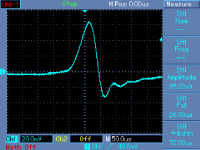
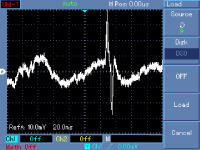
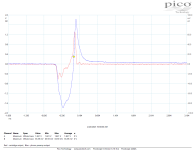
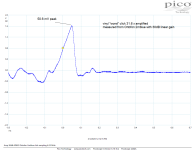
What I know is that yours or Hans's subjective sound perception has very weak relevance to me or to anybody else. So if you tell me that you prefer A over B my reaction is "so what" or "nice to know" at best. Nothing else.
I suggest that you haven't conducted a poll of "anybody else" to be so bold. Furthermore, relevance is oftentimes a cause to take action, hence to suggest not to take action upon the conclusion something is concluded has no relevance asserts a normal human condition. This isn't inspirational.
Isn’t that exactly the point that sound perception is subjective and that we don’t all hear the same.The correlation may be very weak for you but not for somebody else. Repeating your mantra does not make sound perception less subjective.
It’s unmeasurable.
Hans
Absolutely, but only when you are aware of this.Surely this is overcome by good layout practice? I'm trying to understand the relevance here.
Hans
I think it’s time to leave this thread.
There is often so little respect for each other.
Almost every other contribution is critisized.
It’s really true but very sad that phono threads are often that destructive.
Hans
There is often so little respect for each other.
Almost every other contribution is critisized.
It’s really true but very sad that phono threads are often that destructive.
Hans
- Home
- Source & Line
- Analogue Source
- RIAA Overload Performance’ to Encoded Signals (i.e. the Music) and Response to Clicks and Pops (Unencoded)
